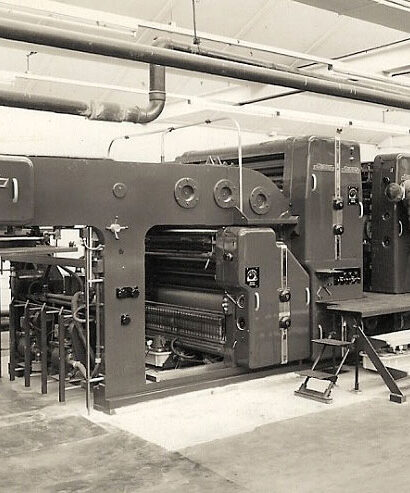The first half of the 20th century witnessed a surge in mass media, forever altering how information and entertainment were consumed and disseminated. Magazines played a crucial role in this revolution, serving as gateways to diverse perspectives, shaping cultural trends, and influencing countless lives.

Several magazines such as ‘the National Geographic Magazine’ (1888), ‘Life’ (1883, but focusing on photojournalism from 1936), ‘Time’ (1923), ‘Vogue’ (1892) and ‘The Reader’s Digest’ (1920) came into existence.
At the heart of this media revolution was the advent of modern printing technology. The printing press, which had been refined and improved since its invention by Johannes Gutenberg in the fifteenth century, underwent further advancements during the early twentieth century. Innovations such as offset printing and rotary presses enabled faster, more efficient, and higher-quality printing processes, making mass production of newspapers and magazines economically viable on a scale never seen before. Let’s delve into the evolution of printing during the initial decades of the 20th century.
1900 – Kolbus starts producing bindery machines

Above are cutting tables and below are machines for laminating and sewing.
The Kolbus ‘Rupert’ was a machine used for rounding book spines and pressing surfaces, and it remained in production for 55 years. It was the first of many book binding machines made by Kolbus.
1902 – Global advertising agencies

McCann credo – Source: Wikimedia commons
McCann Erickson, an advertising company, was started in New York City. It became one of the first global advertising agencies by opening offices in Europe in 1927, South America in 1935, and Australia in 1959.
1903 – Offset lithography is born
In 1901, an American printer named Ira Washington Rubel stumbled upon a discovery by accident. He found that printing from a rubber roller instead of a stone plate made the print clearer and sharper. This led to the development of the first lithographic offset press for paper by the Potter Press Printing Company in New York.
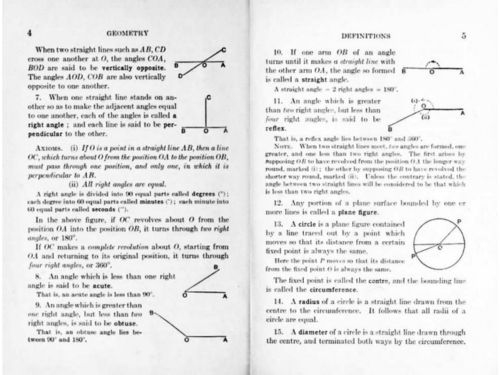
School Geometry by authors Hal and Stevens is published.
This is also the first year that School Geometry by authors Hal and Stevens is published. From 1903 to 1955 millions of copies of this school book get printed.
1906 – Petit Larousse

Le Petit Larousse Illustré,.
Le Petit Larousse Illustré, a single-volume encyclopedia, is published for the first time.
1907 – Using silk for screen printing
Samuel Simon, an Englishman, gets a patent for the process of using silk fabric to print screens. This method, known as screen printing, became popular for making fancy wallpaper and printing on fabrics like linen and silk.
Screen printing had first appeared in China during the Shang Dynasty (960–1279 AD).
1911 – Roland presses and Intertype typesetters
The first Roland offset press is introduced to the market. It’s made in Offenbach, Germany, by Faber & Schleicher AG, a company founded in 1871. They began shipping their first Albatros press four years later. Their 1922 single-color Klein-Roland 00 offset press can print up to 5000 sheets per hour.
US newspaperman Hermann Ridder founds the International Typesetting Machine Company which manufactures the Intertype. This typesetter has a simpler design than the Linotype.
Late 1912 the first machine is installed at the New York Journal of Commerce. It costs $2150, which is over $53000 in today’s currency.
1912 – Offset printing takes off
There are already 560 offset presses in operation in the United States. By the 1930s it is the dominant form of lithography.
1914 – Early graphic arts trade shows
The Bugra trade show happens in Leipzig, Germany. Bugra stands for ‘Internationale Ausstellung für Buchgewerbe und Graphik’. About 2.3 million people attended the show, but its attendance dropped a lot after the First World War.
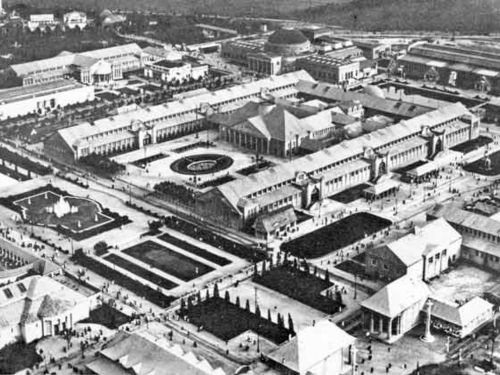
Bugra trade show takes place in Leipzig, Germany.
Later, Leipzig became part of East Germany after the Second World War, and the Drupa trade shows started in Düsseldorf, which is like the successor to Bugra.
The Linotype hot metal typesetter Model 14 offers the option to have one, two, or three full-size magazines with different typefaces, similar to Model 8. What’s different is that it now includes an extra magazine that doesn’t get in the way when you change or remove the main ones.
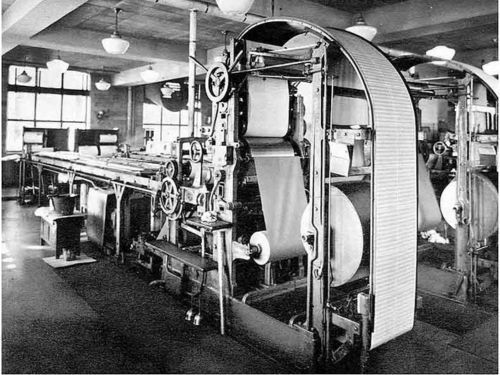
Packaging printing between 1910 and 1920 – Source: Library of congress
To switch between different typefaces and sizes, the operator can simply turn a handle without needing to stand up from their chair.
1915 – First Hallmark Christmas cards

Hallmark, founded in 1910, creates its first Christmas card.
Hallmark, founded in 1910, creates its first Christmas card. The example above is from that era. Forty years earlier Boston printer Louis Prang had been the first to offer a line of Christmas cards in the USA.
1921 – Pearson moves into publishing
Pearson, once a construction and engineering firm, buys many local newspapers in the UK. Over time, it becomes one of the biggest educational publishers and book printers globally. Its companies include Prentice Hall, Longman, Peachpit, and Addison-Wesley.
1922 – Graphic design becomes a term
Book and type designer William Addison Dwiggins came up with the term ‘graphic designer’ to describe his work, where he organizes and gives visual shape to printed materials. However, the term became commonly used only after the Second World War.
1923 – KBA prints banknotes & Komori is founded

Four-color Iris press from Koenig & Bauer
The four-color Iris press from Koenig & Bauer can be used for printing banknotes. Over time security printing becomes one of the main focus points of the company.
1932 – AMC
Addressograph International merges with American Multigraph to form the Addressograph-Multigraph Corporation. This new company will be a major player in the market for addressing and duplicating machines for many years to come. The picture below depicts a tin container holding ribbons used for labeling envelopes with an Addressograph machine.
1934 – Bobst Autovariable
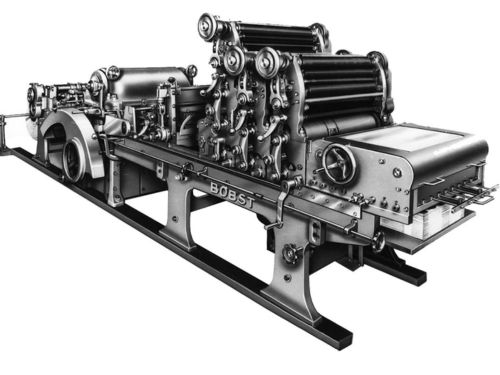
Bobst Autovariable
The Autovariable is a press for cutting and printing cardboard boxes. It became very popular at the Foire de Paris and helped save the Swiss company, which was founded in 1890, from going out of business. Their next big success was the Bobst AP 900 automatic die-cutter, which came out in 1940.
1935 – First paperbacks and adhesive labels
Penguin Books in the UK starts selling a successful series of paperback books, making them affordable for more people. Before that, in 1931, Albatross Books in Germany also tried to sell cheaper books with paper covers and glue binding, but it didn’t work out.
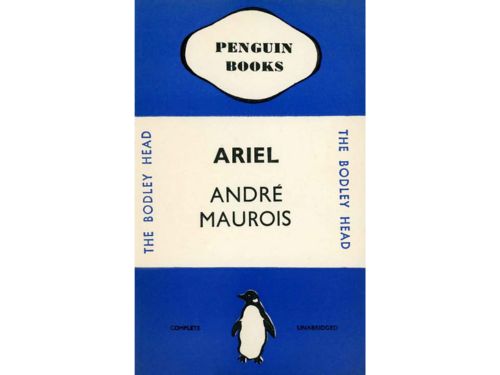
Series of paperback books is published by Penguin Books in the UK.
Penguin learned from their mistakes and used similar ideas, like color-coded covers. These books cost sixpence each, the same price as a pack of cigarettes.
1938 – Xerography is invented and Planeta came into existence
Xerography, a dry photocopying technique, is invented by Chester F. Carlson. In 1947 Haloid Company, now known as Xerox, obtains a license to commercialize the technology.
In 1938, a company called Dresden-Leipziger Schnellpressenfabrik AG changed its name to Planeta. Six years earlier, they made the world’s first four-color web offset press. After World War II, Planeta became the biggest press maker in East Germany. In 1991, it was bought by Koenig & Bauer (KBA).
1939 – Cold-glueing takes off
Emil Lumbeck is the first one to successfully use cold-glue binding for books (Lumbeck-Kaltklebebindung).
1940 – Miehle MV-50

Miehle MV-50- Vertical Cylinder Press
The V-50 is the latest in a series of vertical cylinder presses that combine easy access and convenience with a compact footprint. It can print 5000 14×20″ sheets per hour. Miehle’s letterpresses will still be produced until 1978, gradually losing market share to offset lithography presses. Of the 25000 that were built thousands are still in use today for die cutting or scoring (adding a mechanical crease to sheets so they can be folded more easily).
1947 – Polar starts building electrically powered cutters
Polar build the Einmesser-Schnellschneider, their first electrically powered cutting machine. In 1954 they build the first cutters with an optical cutting line indicator and air cushion table.
1948 – Shinohara
Shinohara Machinery Company, the Japanese machine tool manufacturer which had been established in 1919, begins manufacturing flatbed letterpress machines.
1949 – First scans of color images
The July issue of Fortune magazine contains the first commercial scanned color image. It is produced using a scanner built by the Austin Company.
Machine Dalal is a global platform for buyers and sellers to connect and trade their equipment with ease. Contact us to learn more.


